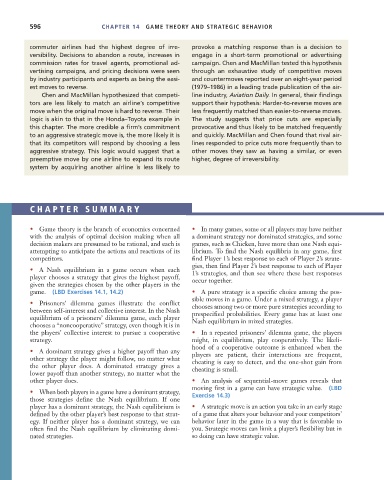Page 622 - Microeconomics, Fourth Edition
P. 622
c14gametheoryandstrategicbehavior.qxd 8/6/10 8:22 AM Page 596
596 CHAPTER 14 GAME THEORY AND STRATEGIC BEHAVIOR
commuter airlines had the highest degree of irre- provoke a matching response than is a decision to
versibility. Decisions to abandon a route, increases in engage in a short-term promotional or advertising
commission rates for travel agents, promotional ad- campaign. Chen and MacMillan tested this hypothesis
vertising campaigns, and pricing decisions were seen through an exhaustive study of competitive moves
by industry participants and experts as being the easi- and countermoves reported over an eight-year period
est moves to reverse. (1979–1986) in a leading trade publication of the air-
Chen and MacMillan hypothesized that competi- line industry, Aviation Daily. In general, their findings
tors are less likely to match an airline’s competitive support their hypothesis: Harder-to-reverse moves are
move when the original move is hard to reverse. Their less frequently matched than easier-to-reverse moves.
logic is akin to that in the Honda–Toyota example in The study suggests that price cuts are especially
this chapter. The more credible a firm’s commitment provocative and thus likely to be matched frequently
to an aggressive strategic move is, the more likely it is and quickly. MacMillan and Chen found that rival air-
that its competitors will respond by choosing a less lines responded to price cuts more frequently than to
aggressive strategy. This logic would suggest that a other moves they saw as having a similar, or even
preemptive move by one airline to expand its route higher, degree of irreversibility.
system by acquiring another airline is less likely to
CHAPTER SUMMAR Y
• Game theory is the branch of economics concerned • In many games, some or all players may have neither
with the analysis of optimal decision making when all a dominant strategy nor dominated strategies, and some
decision makers are presumed to be rational, and each is games, such as Chicken, have more than one Nash equi-
attempting to anticipate the actions and reactions of its librium. To find the Nash equilibria in any game, first
competitors. find Player 1’s best response to each of Player 2’s strate-
gies, then find Player 2’s best response to each of Player
• A Nash equilibrium in a game occurs when each 1’s strategies, and then see where these best responses
player chooses a strategy that gives the highest payoff, occur together.
given the strategies chosen by the other players in the
game. (LBD Exercises 14.1, 14.2) • A pure strategy is a specific choice among the pos-
sible moves in a game. Under a mixed strategy, a player
• Prisoners’ dilemma games illustrate the conflict chooses among two or more pure strategies according to
between self-interest and collective interest. In the Nash prespecified probabilities. Every game has at least one
equilibrium of a prisoners’ dilemma game, each player Nash equilibrium in mixed strategies.
chooses a “noncooperative” strategy, even though it is in
the players’ collective interest to pursue a cooperative • In a repeated prisoners’ dilemma game, the players
strategy. might, in equilibrium, play cooperatively. The likeli-
hood of a cooperative outcome is enhanced when the
• A dominant strategy gives a higher payoff than any players are patient, their interactions are frequent,
other strategy the player might follow, no matter what cheating is easy to detect, and the one-shot gain from
the other player does. A dominated strategy gives a cheating is small.
lower payoff than another strategy, no matter what the
other player does. • An analysis of sequential-move games reveals that
moving first in a game can have strategic value. (LBD
• When both players in a game have a dominant strategy, Exercise 14.3)
those strategies define the Nash equilibrium. If one
player has a dominant strategy, the Nash equilibrium is • A strategic move is an action you take in an early stage
defined by the other player’s best response to that strat- of a game that alters your behavior and your competitors’
egy. If neither player has a dominant strategy, we can behavior later in the game in a way that is favorable to
often find the Nash equilibrium by eliminating domi- you. Strategic moves can limit a player’s flexibility but in
nated strategies. so doing can have strategic value.

